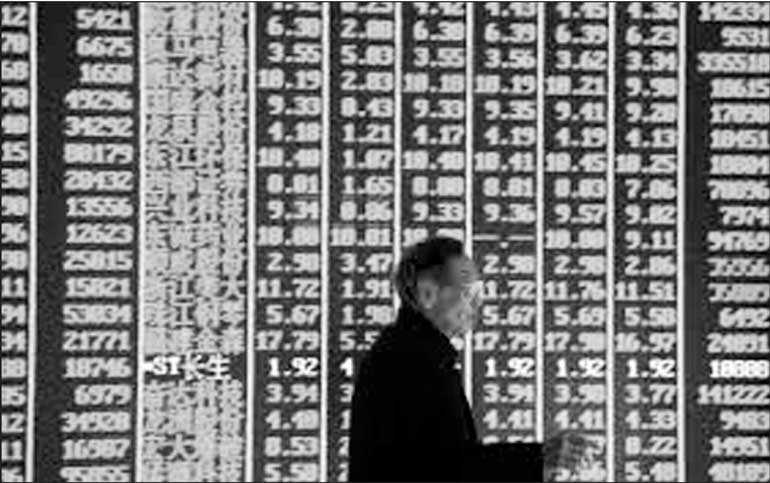Friday Apr 26, 2024
Friday Apr 26, 2024
Saturday, 8 June 2019 00:01 - - {{hitsCtrl.values.hits}}

A man is seen in front of an electronic board showing stock information on the first day of trading in the Year of the Pig, following the Chinese Lunar New Year holiday, at a brokerage house in Hangzhou, Zhejiang Province, China 11 February – Reuters
SYDNEY (Reuters): Asian shares were slightly higher on Friday on expectations global central banks will soon embark on an easing cycle in the face of international trade frictions and fears of a world recession.
Those concerns blunted some of the optimism, with liquidity light during Asian trading as China and Hong Kong markets were shut for a public holiday.
Japan’s Nikkei ended 0.5% higher, Australia’s benchmark index climbed 0.8% while South Korea’s Kospi added 0.4%.
In early European trades, the pan-region Euro Stoxx 50 futures were up 0.3%, German DAX futures gained 0.4 while FTSE futures rose 0.2%.
E-Minis futures for the S&P500 were last up 0.2%, pointing to a positive opening for US markets.
“Central banks are waiting for one man to act; Donald Trump,” said Chris Weston, head of research at Melbourne-based broker Pepperstone, as markets fretted over the US president’s tariff threats on a number of countries including China and Mexico.
“July will be a big month of central bank easing,” he added. “They hold a wait-and-see attitude and will be nimble in accordance with the developments.”
Financial markets are pricing in a 67% chance of a cut by the US Federal Reserve at its 31 July meeting while there is a near 60% chance of a second easing by New Zealand and Australian central banks next month.
In China, central bank chief Yi Gang said there was plenty of room for fiscal and monetary policy easing if the protracted trade war with the United States worsened.
Yi signalled the yuan could ease below 7 if US-China trade relations turned even more acrimonious. The remarks sent the dollar 0.2% higher in a thin Asian market to 6.9429.
As expectations grow for the Fed to lower rates, the dollar index, which measures the greenback against a basket of major currencies, has eased 0.7% this week so far. It was flat at 97.054.
Investors are now focused on the US employment report later in the day for further cues about the health of the world’s largest economy.
Market forecasts are for jobs to rise a solid 185,000 in May and unemployment to stay at a low 3.6%, though much was in doubt after dismal data on private hiring released earlier in the week.
“We haven’t adjusted our projection of 185,000 for overall nonfarm payrolls in May,” said Kevin Cummins, senior US economist at RBS.
“However, any major surprises in May payrolls seem tilted to the low side of our forecast, which wouldn’t be too surprising given the rising uncertainty in the outlook in the US and the above-trend gain registered in April.”
Oddly, a weak number might actually prove positive for equities since it would bolster the case for an early rate cut from the Federal Reserve.
Markets have fully priced in a cut by September, and a further two easings by mid-2020.
Two-year Treasury yields were near their lowest since December 2017 at 1.88%, having fallen 28 basis points in just two weeks.
That was one reason Asian shares were higher on Friday, though uncertainty about the global trade disputes checked investors’ enthusiasm.
Mexican and US officials had held a second day of talks on Thursday amid reports President Donald Trump might delay the imposition of tariffs that was due on Monday.
The White House later said the tariffs would go ahead as scheduled, and there were reports Trump might declare a national emergency to dodge any Senate objections.
In currencies, the dollar was steady on the yen at 108.45 and was off its recent five-month low of 107.80.
It fared less well on the euro which was currently holding gains of almost 0.9% for the week at $1.1267.
The single currency bounced sharply overnight after the European Central Bank pushed back the timing of any rate hike, but failed to canvas the policy easing that many had wagered on.
Money market futures are now pricing in a 45% chance of a 10 basis point euro zone rate cut by the end of year versus 75% before the ECB statement.
“The killer punch came at the press conference with President Draghi disappointing market’s dovish policy pricing with a series ‘optimistic’ remarks,” noted Rodrigo Catril, a senior FX strategist at NAB.
“The risk is that once the ECB realises things are really bad, it will find itself well behind the curve.”
In commodity markets, all the chatter of rate cuts globally kept gold near 15-week highs at $1,332.89 per ounce.
Oil prices regained a little ground after a rough week but was still vulnerable to worries about global demand and oversupply.
Brent crude futures bounced 92 cents to $62.59, but were still down nearly 3% for the week so far, while US crude firmed 79 cents at $53.38 a barrel.